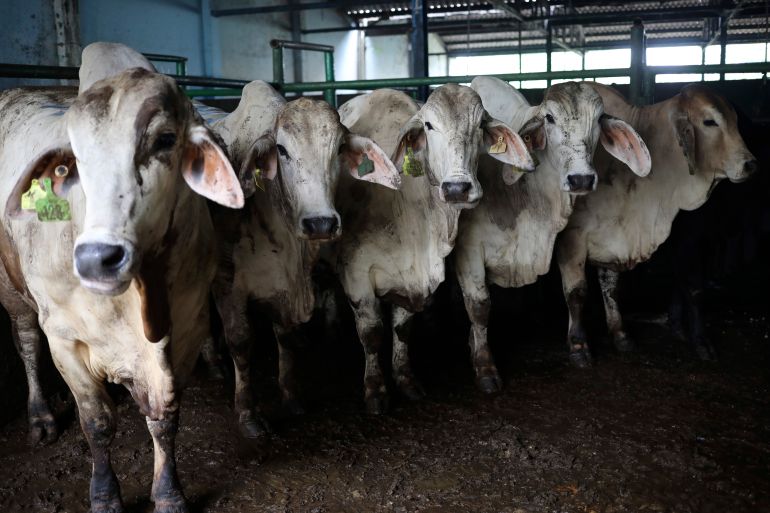The Art of Raising Constance Cattle: Specialist Advice on Nutrition, Housing, and Welfare
The Art of Raising Constance Cattle: Specialist Advice on Nutrition, Housing, and Welfare
Blog Article
Master the Art of Food Preparation With Lawn Fed Meat
In the realm of cooking proficiency, grasping the art of food preparation with grass-fed meat holds a prestigious setting. From the tender structure to the durable taste profile, grass-fed meat provides a canvas for cooking creative thinking.
Advantages of Grass-Fed Meat

When choosing grass-fed meat, consumers can take advantage of its higher levels of omega-3 fatty acids and antioxidants compared to conventionally raised meat. Constance Cattle. Omega-3 fatty acids are important nutrients that support brain health, decrease inflammation, and promote heart health. Grass-fed meat is known to have up to five times much more omega-3 fatty acids than grain-fed meat, making it a healthier selection for those looking to increase their consumption of these advantageous fats
Along with omega-3 fats, grass-fed meat is additionally richer in anti-oxidants such as vitamins E and C, in addition to beta-carotene. Antioxidants play an important function in safeguarding cells from damage triggered by complimentary radicals, which can add to numerous persistent illness and accelerate aging. By going with grass-fed meat, consumers can not only enjoy a more nutrient-dense and flavorful protein source but additionally sustain their general health and wellness and well-being.
Including grass-fed meat right into your diet can be a simple yet reliable means to improve your nutritional consumption and profit of omega-3 fats and antioxidants that are normally plentiful in this kind of meat.
Ideal Food Preparation Techniques
Utilizing ideal food preparation methods is important to protect the nutrient profile and improve the flavor of grass-fed meat. When cooking grass-fed meat, it is vital to bear in mind that it is leaner than traditionally raised meat, making it extra susceptible to drying out if overcooked. To make sure a juicy and tasty end result, consider cooking grass-fed meat at slightly lower temperatures than you would with grain-fed meat.
Barbecuing is a preferred method for cooking grass-fed meat as it allows excess fat to drip away, avoiding flare-ups that can create charring. When grilling grass-fed meat, use medium warm and maintain a close eye on it to stop overcooking. Another terrific food preparation method for grass-fed meat is pan-searing. This technique assists seal in the juices and develop a delicious crust on the meat.
Sluggish cooking techniques such as braising or cooking are likewise superb options for tougher cuts of grass-fed meat, as they assist damage down the muscle mass fibers and soften the meat. Whichever food preparation method you select, remember to allow grass-fed meat rest after preparing to permit the juices to rearrange, guaranteeing a damp and tender final recipe.
Flavor Pairings and Seasonings
To improve the natural flavors of grass-fed meat, strategic flavor pairings and seasonings play an essential function in raising the overall eating experience. Grass-fed meat has an abundant, unique preference that can be matched and enhanced by meticulously selected ingredients. When it involves flavor pairings, herbs like oregano, rosemary, and thyme job remarkably well with grass-fed beef, lamb, or bison. These herbs add deepness and earthiness to the meat, improving its all-natural flavors without overpowering them.
In addition to natural herbs, spices such as black pepper, garlic, and smoked paprika can better boost the taste profile of grass-fed meat recipes. These flavors provide an equilibrium of warmth, sweet taste, and smokiness that can boost the overall eating experience. When flavoring grass-fed meat, it is vital a knockout post to make use of premium salt, like sea salt or Himalayan salt, to draw out the meat's flavors without adding unneeded chemicals or ingredients.
Storage Space and Taking Care Of Tips
Correct storage space and handling methods are crucial for keeping the quality and freshness of grass-fed meat. When keeping grass-fed meat, it is vital to keep it cooled at temperature levels below 40 ° F(4 ° C) to avoid microbial development and putridity. To expand the meat's life span, think about covering it firmly here are the findings in parchment paper or butcher paper before putting it in an airtight container or secured plastic bag - Constance Cattle. Stay clear of saving grass-fed meat near strong-smelling foods as it can take in smells quickly.
When taking care of grass-fed meat, it is essential to practice great hygiene to avoid cross-contamination. Wash your hands extensively prior to and after taking care of the meat, and make certain that all tools and surfaces that enter into call with the meat are cleansed and sterilized properly. Additionally, use separate cutting boards for meat and veggies to prevent bacterial transfer.

Leading Grass-Fed Meat Recipes
When thinking about the very best ways to relish the quality and freshness of grass-fed meat, exploring superior dishes can boost your cooking experience. Grass-fed meat's rich taste and leaner profile lend themselves well to a variety of dishes that highlight the all-natural goodness of the meat. One top recipe to attempt is a classic Grilled Grass-Fed Ribeye Steak seasoned with simple ingredients like salt, pepper, and a touch of garlic for a robust flavor. For a calming meal, a Slow Cooked Grass-Fed Beef Stew with origin vegetables and fragrant herbs is a hearty choice that brings out the meat's tenderness.
If you're in the mood for something lighter, a Grilled Grass-Fed Hamburger offered with fresh garnishes and a side of wonderful potato fries is a tasty option. In addition, a Herb-Crusted Grass-Fed Shelf of Lamb roasted to perfection with a collection of natural herbs and breadcrumbs is a show-stopping recipe for unique occasions. These leading grass-fed meat dishes showcase the adaptability and superior high quality of grass-fed meat, enabling you to enjoy its superior taste in numerous cooking developments.

Conclusion
Finally, understanding the art of cooking with grass-fed meat uses countless benefits, including boosted dietary value and remarkable taste. By utilizing the most effective cooking approaches, trying out flavor pairings and spices, and view website adhering to proper storage and handling pointers, you can develop delicious and nourishing meals. Experiment with some top grass-fed meat dishes to elevate your cooking skills and enjoy the complete possibility of this top notch ingredient.
When cooking grass-fed meat, it is essential to remember that it is leaner than conventionally elevated meat, making it much more susceptible to drying out if overcooked. To make certain a juicy and flavorful result, think about cooking grass-fed meat at slightly reduced temperature levels than you would with grain-fed meat.
When flavoring grass-fed meat, it is essential to use high-grade salt, like sea salt or Himalayan salt, to bring out the meat's flavors without adding unneeded chemicals or ingredients.
Grass-fed meat's abundant flavor and leaner profile offer themselves well to a variety of meals that highlight the all-natural benefits of the meat. These leading grass-fed meat dishes showcase the adaptability and superior quality of grass-fed meat, permitting you to appreciate its superior preference in different cooking developments.
Report this page